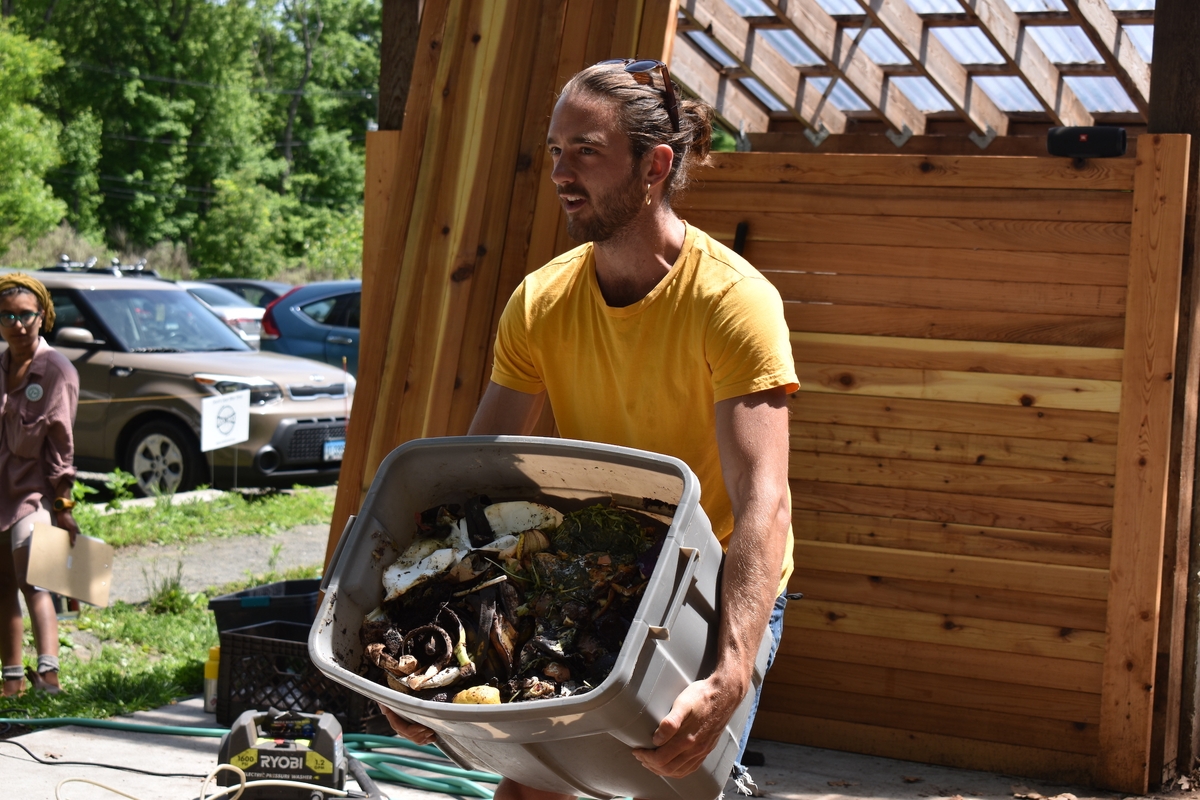
Laura Glesby Photo
Neighbors welcome: Clancy Emanuel begins compost demonstration at expanded operation.
A heap of discarded orange peels, eggshells, peanuts, and vegetables of every hue came one step closer to becoming reusable compost — by way of long shovels, animal poop, dead leaves, a group of committed community members, and an influx of federal funding for Common Ground High School’s urban farm.
City officials and Common Ground educators gathered on Wednesday afternoon at the charter high school’s newly-revamped and expanded compost system to celebrate a $90,000 cooperative agreement among the city’s Food System Policy Division, Common Ground, and the United States Department of Agriculture.
The funding allowed Common Ground to expand its compost system, which started at the school in the 1990s, to a capacity of about 45,000 tons per year.
Boosted by the new funding, New Haven Food System Policy Division and Common Ground leaders encouraged community members to contribute their own food waste — and to open private compost systems for public use, when possible.

Latha Swamy shares hopes for the program to expand.
“We’re only a small strand of the broader food waste system and what it could be,” said Deborah Greig, Common Ground’s farm director.
Food System Policy Division Director Latha Swamy said the city hopes to broaden the array of public compost facilities to enable “composting for all,” by tapping into existing community gardens and schools that make use of urban agriculture. “We want to truly create an environment where everyone, everyone” — especially communities that may not be able to afford private food waste services — “can compost.”
Members of the public are able to drop off their compost at Common Ground at 358 Springfield Ave. as well as the Stevens Street Community Garden at 47 Stevens St., free of charge. (The Peels & Wheels composting organization at 15 James St. offers both pick-up and drop-off services for a regular fee.) The precise waste specifications and hours for each facility can be found at this website.
Common Ground’s Program Coordinator Clancy Emanuel walked city officials and school leaders Wednesday through the composting process. The group poured food scraps into piles of soil, carbon-rich leaves, and nitrogen-rich feces from the farm animals that live at the school. They broke up the food into small chunks and folded every ingredient together. Then, they shoveled the mix into a larger compost heap still accepting food scraps.
Wednesday’s pile will sit for more than a month, with occasional waterings, before it’s “turned” and mixed again. In the meantime, bugs and small animals will help digest the food waste. The pile’s temperature will heat up to about 160 degrees because of the carbon dioxide it releases (unlike landfills, compost piles produce minimal methane emissions, which are a particularly potent contributor to climate change).
According to Emanuel, it takes slightly less than a school year to go through a full composting cycle at Common Ground.

Wednesday's compost.
The Food System Policy Division estimates that New Haven households produce 22,471 tons of food waste each year.
Since New Haven does not have a way of processing its own municipal solid waste, the city currently pays Bridgeport and Hartford to incinerate trash. Statewide, food waste makes up about 40 percent of trash that goes to landfills or incinerators.
Mayor Justin Elicker, the former executive director at the New Haven Land Trust and a home composter himself, said the city’s investment in compost systems “makes sense from an environmental perspective, it makes sense from a waste management perspective, and it makes sense from a financial perspective.”

Justin Elicker pitches in.

Sam Oathout.
Common Ground’s compost pile doubles as a public service and a classroom. Twelfth grader Sam Oathout has produced about 400 pounds of compost during his time at Common Ground. Oathout spoke about his experience learning about waste management, building small compost stations, and eventually teaching younger students about the process.
As city and school leaders shoveled compost into a massive heap, the smell of sour mulch filled the air. So did the weight of current events.
The compost’s location in a high school’s backyard took on a heavy resonance the day after a school shooting in Uvalde, Texas. Elicker held a moment of silence for the 19 children and two teachers who were murdered in that killing spree.
In the face of the climate disaster that will affect childrens’ lives even more than the lives of their parents, Greig said that teaching about compost offers her a pathway through anxiety and fear.
“When climate issues feel overwhelming, there is power and agency in taking a banana peel and turning it into compost,” she said.

Mixing the compost ingredients.



Common Grounds is pretty much set in a rural area I'm wondering how much wildlife and rodent activity is attracted to feed there.